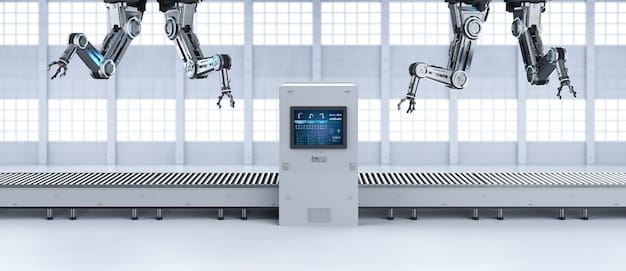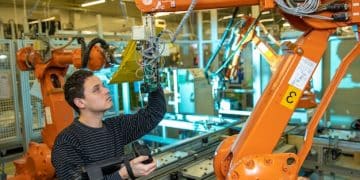Machine Learning for Predictive Maintenance: Cut Downtime by 25%

Machine Learning for Predictive Maintenance leverages algorithms to analyze equipment data, predict potential failures, and optimize maintenance schedules, resulting in a potential 25% reduction in downtime in manufacturing environments.
In the fast-paced world of manufacturing, downtime is the enemy. But what if you could predict equipment failures before they happen? Machine Learning for Predictive Maintenance is revolutionizing how manufacturers approach maintenance, promising to reduce equipment downtime by as much as 25%. Imagine the cost savings and efficiency gains – let’s explore how this is possible.
Understanding Machine Learning for Predictive Maintenance
Machine learning (ML) is rapidly changing how various industries operate, and manufacturing is no exception. Predictive maintenance, powered by ML, is emerging as a game-changer, offering a proactive approach to equipment upkeep that minimizes unexpected breakdowns and maximizes operational efficiency. It’s about moving from reactive to predictive.
Predictive maintenance utilizes data analysis and machine learning algorithms to forecast when equipment is likely to fail. This allows maintenance teams to schedule interventions proactively, before the failure occurs, reducing downtime and associated costs. This approach is fundamentally different from traditional methods.
Traditional vs. Predictive Maintenance
Traditional maintenance strategies often fall into two categories: reactive and preventative. Reactive maintenance involves fixing equipment after it breaks down, leading to unplanned downtime and potential production losses. Preventative maintenance follows a predetermined schedule, replacing parts or performing maintenance tasks at fixed intervals, regardless of the equipment’s actual condition.
Predictive maintenance, on the other hand, uses real-time data and machine learning to assess the condition of equipment and predict future failures. This allows for maintenance to be performed only when necessary, optimizing resource allocation and minimizing unnecessary downtime. This leads to significant cost savings.
- Reactive Maintenance: Fix it when it breaks. High downtime risk.
- Preventative Maintenance: Scheduled maintenance regardless of condition. Potential for wasted resources.
- Predictive Maintenance: Data-driven maintenance based on real-time condition. Minimizes downtime and optimizes resources.
In essence, machine learning for predictive maintenance provides a smarter, more efficient way to keep manufacturing operations running smoothly. By accurately predicting when maintenance is needed, it minimizes disruptions and maximizes the lifespan of valuable equipment.

The Role of Data in Predictive Maintenance
Data is the lifeblood of any effective predictive maintenance system. The algorithms that power these systems rely on accurate and comprehensive data to learn patterns, identify anomalies, and forecast potential failures. The quality and quantity of data are critical for achieving reliable predictions.
Various types of data can be used in predictive maintenance, including sensor data, operational data, and maintenance records. Sensor data provides real-time information about the equipment’s performance and condition, while operational data captures historical information about its usage and output. Maintenance records offer insights into past repairs and failures.
Types of Data Used
Effective predictive maintenance systems leverage a variety of data sources to achieve accurate predictions. Understanding the different types of data and their potential contributions is key to building a robust system.
Sensor data, collected from equipment through various sensors, provides real-time insights into operating conditions. Operational data, including production rates and environmental factors, offers a broader context for understanding equipment performance. Maintenance history provides valuable information about past failures and repairs.
- Sensor Data: Real-time data from sensors monitoring temperature, vibration, pressure, etc.
- Operational Data: Production rates, environmental conditions, and operating parameters.
- Maintenance History: Records of past repairs, replacements, and maintenance activities.
Ultimately, the success of machine learning for predictive maintenance hinges on the quality and availability of data. By leveraging a diverse range of data sources, manufacturers can create more accurate and reliable prediction models.
Implementing Machine Learning Algorithms
Implementing machine learning algorithms is at the heart of predictive maintenance. Several algorithms can be used to analyze data and predict equipment failures. The choice of algorithm depends on the type of data available, the complexity of the equipment, and the desired level of accuracy.
Common machine learning algorithms used in predictive maintenance include regression models, classification models, and clustering algorithms. Regression models can predict continuous values, such as the remaining useful life of a component. Classification models can predict discrete outcomes, such as whether a piece of equipment will fail within a certain time period. Clustering algorithms can identify groups of similar equipment, allowing for targeted maintenance strategies.
Popular Machine Learning Algorithms
Choosing the right algorithm is crucial for the success of a predictive maintenance program. Each algorithm has its strengths and weaknesses, and the optimal choice depends on the specific application.
Regression models are useful for predicting continuous variables, such as the remaining useful life of a component. Classification models are effective at predicting discrete outcomes, such as whether a piece of equipment will fail within a certain time frame. Time series analysis is particularly well-suited for analyzing sensor data collected over time, identifying trends and anomalies that may indicate impending failures.
- Regression Models: Predict remaining useful life of components.
- Classification Models: Predict if equipment will fail within a timeframe.
- Time Series Analysis: Analyze sensor data to identify trends and anomalies.
By carefully selecting and implementing the appropriate machine learning algorithms, manufacturers can create effective predictive maintenance systems that minimize downtime and maximize operational efficiency.
Benefits of Machine Learning in Manufacturing
The integration of machine learning in manufacturing processes offers significant benefits, particularly in reducing equipment downtime. Predictive maintenance facilitates substantial cost savings, improves overall efficiency, and enhances the lifespan of machinery.
By predicting equipment failures before they occur, manufacturers can schedule maintenance interventions proactively, minimizing unexpected downtime and production losses. This leads to significant cost savings in terms of reduced repair costs, minimized downtime, and optimized resource allocation. Furthermore, predictive maintenance can extend the lifespan of equipment by ensuring that maintenance is performed only when necessary.
Quantifiable Advantages
Adopting machine learning for predictive maintenance presents numerous quantifiable advantages, driving improvements across various operational aspects of manufacturing.
Reduced downtime translates directly into increased production output and revenue. Cost savings are realized through optimized maintenance schedules and reduced repair expenses. Increased equipment lifespan results from proactive maintenance preventing major failures.
- Reduced Downtime: Minimizes production losses due to unexpected failures.
- Cost Savings: Optimizes maintenance schedules and reduces repair costs.
- Increased Equipment Lifespan: Proactive maintenance prevents major failures.
In conclusion, implementing machine learning for predictive maintenance in manufacturing operations provides significant benefits that directly contribute to improved efficiency, reduced costs, and increased profitability.

Challenges and Considerations
While the potential of machine learning for predictive maintenance is substantial, there are challenges to consider. Successful implementation requires careful planning, data management, and ongoing monitoring.
One of the primary challenges is data quality. Machine learning algorithms require accurate and comprehensive data to make reliable predictions. Insufficient or inaccurate data can lead to poor predictions and ineffective maintenance strategies. Another challenge is algorithm selection. The choice of algorithm depends on the type of data available and the complexity of the equipment. Ongoing monitoring is necessary to ensure that the system continues to perform effectively over time.
Overcoming Implementation Hurdles
Successfully implementing machine learning for predictive maintenance requires a strategic approach to address potential hurdles and ensure a smooth transition.
Data quality can be improved by implementing robust data collection and validation procedures. Algorithm selection should be guided by expert knowledge and experimentation. Ongoing monitoring can be achieved through the use of key performance indicators (KPIs) and regular system audits.
- Data Quality: Implement robust data collection and validation procedures.
- Algorithm Selection: Guided by expert knowledge and experimentation.
- Ongoing Monitoring: Use KPIs and regular system audits.
By proactively addressing these challenges, manufacturers can maximize the value of machine learning for predictive maintenance and achieve significant improvements in operational efficiency and cost savings.
Future Trends in Predictive Maintenance
The field of predictive maintenance is constantly evolving, with new technologies and techniques emerging regularly. Staying abreast of these trends is essential for manufacturers who want to remain competitive and maximize the value of their predictive maintenance programs.
One emerging trend is the use of artificial intelligence (AI) to automate the process of algorithm selection and optimization. AI-powered systems can analyze data and automatically choose the most appropriate algorithms for a given application. Another trend is the use of edge computing to process data closer to the source, reducing latency and improving real-time decision-making.
Emerging Technologies
Several emerging technologies are poised to further enhance the capabilities of predictive maintenance systems, enabling more accurate predictions and proactive interventions.
The Internet of Things (IoT) is expanding the availability of real-time data from equipment, providing a richer data stream for predictive models. Cloud computing offers scalable and cost-effective infrastructure for storing and processing large volumes of data. Artificial intelligence (AI) automates algorithm selection and optimization.
- Internet of Things (IoT): Expands the availability of real-time data.
- Cloud Computing: Provides scalable and cost-effective infrastructure.
- Artificial Intelligence (AI): Automates algorithm selection and optimization.
As these technologies continue to mature, they will enable manufacturers to unlock even greater value from their predictive maintenance programs, further reducing downtime and maximizing operational efficiency.
| Key Point | Brief Description |
|---|---|
| ⚙️ Data-Driven | Uses data to predict equipment failures. |
| 💰 Cost Reduction | Minimizes downtime and repair costs. |
| 📈 Efficiency | Improves manufacturing efficiency significantly. |
| 💡 Machine Learning | Uses algorithms to predict potential failures. |
Frequently Asked Questions
▼
Predictive maintenance uses data analysis and machine learning to forecast when equipment is likely to fail. This allows maintenance teams to schedule interventions proactively.
▼
Machine learning algorithms analyze equipment data to identify patterns and anomalies that indicate potential failures. This enables proactive maintenance and minimizes downtime.
▼
Sensor data, operational data, and maintenance records are crucial. Sensor data provides real-time information; operational data captures usage and output history; maintenance records provide insights from past repairs.
▼
The benefits include reduced downtime, lower maintenance costs, and extended equipment lifespan. By proactively addressing potential issues, manufacturers can improve efficiency and profitability.
▼
Challenges include ensuring data quality, selecting the right algorithms, and ongoing monitoring. Addressing these challenges is vital for successful predictive maintenance implementation and maximizing its value.
Conclusion
Machine Learning for Predictive Maintenance offers a powerful solution for manufacturers seeking to optimize their operations and minimize downtime. By leveraging data and advanced algorithms, manufacturers can proactively address potential equipment failures, leading to significant cost savings and improved efficiency. As technology continues to evolve, the potential of predictive maintenance will only continue to grow, providing even greater value in the years to come.





